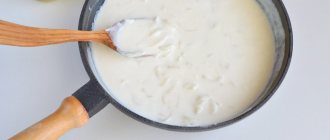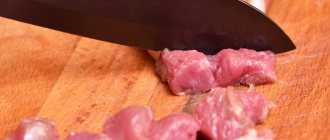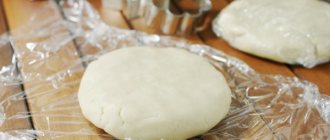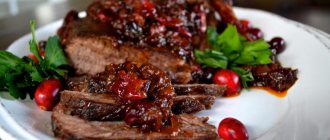8
Prepared by: Alexey Marchuk
07/04/2014 Cooking time: 2 hours 0 minutes
| Save | I cooked) | Estimate |
When buying sausage in a store, you cannot be sure of its quality. I suggest making delicious homemade lung sausage right at home. Fragrant and tasty - it will become irreplaceable!
Sausages with mushrooms
Sausages with mushrooms. Photo: Oleg Kulagin/BurdaMedia You will need: For 4 servings
- 500 g beef or pork tenderloin,
- 200 g fresh champignons,
- 3 onions,
- 80 g butter,
- pepper, salt,
- a few sprigs of fresh herbs for decoration.
Preparation:
- Prepare the champignons: if necessary, clean and wipe with a damp cloth. Boil the mushrooms, let cool slightly and chop finely.
- Peel the onion and cut into small cubes. Sauté in 1 tbsp. spoon of butter until golden brown. Add chopped champignons and simmer together. Add salt and pepper to taste.
- Rinse the meat with cold water, dry and cut into thin slices. Beat well to get very thin meat “pancakes”. Place a spoonful of cooked minced mushroom on each and wrap it like you would wrap it in pancakes made from dough.
- Fry meat sausages stuffed with mushrooms in the remaining butter. Place on a plate and serve with baked apples or potatoes, garnishing the dish with sprigs of herbs.
How to make pork sausage without intestines
Ingredients:
- pork pulp – 2 kg;
- basil, oregano, rosemary – 1\2 tsp each;
- garlic – 5-6 cloves;
- egg – 1 pc.;
- coriander - on the tip of a teaspoon;
- salt, ground pepper - to taste;
- dry cream – 60 g.
Cooking time – 2.5 hours.
Calorie content – 375 kcal.
In order for the sausage to be very tasty, the minced meat must be tender. Initially, we scroll it through a meat grinder at the finest setting, then grind it again using a blender. Review the minced meat carefully and remove all veins, if any. Add spices, egg, cream and blend well again with a blender.
From the resulting meat mixture we form sausages of medium thickness and place them on baking paper. Wrap the paper and tie the edges with twine. We do this until all the minced meat is gone. Then place each sausage in foil and roll it tightly again.
Place the rolls in a deep saucepan, add water and bring to a boil. It is better to cover the top with a plate so that the sausages do not float. Cook for a little over an hour over low heat.
After that, take them out of the water, cool them completely and place them in the refrigerator for at least 12 hours. Then remove the foil and parchment. Before serving, the sausage should be fried, but it will also be very tasty without frying.
Holiday sausages
Holiday sausages. Photo: Oleg Kulagin/BurdaMedia
You will need:
- 1 kg beef fillet,
- 1 small onion
- 50 g Russian cheese,
- 1 bun,
- 50 ml milk,
- 400 ml sour cream,
- 3 tbsp. spoons of tomato paste,
- salt, ground black pepper.
Preparation:
- Cut the fillet into wide slices, beat, salt and pepper. If desired, brush with mustard.
- Peel the onion, cut into small cubes. Grate the cheese. Cut the crust off the bun and soak the crumb in milk. Then squeeze and mix with onion and cheese. Season to taste with salt and pepper.
- Place the filling on the pieces of meat and roll the sausages so that the filling is closed at the edges, otherwise the cheese will leak out.
- Place the sausages in a saucepan, pour in a mixture of sour cream and tomato paste. If the sauce does not cover the sausages, add a little water. Season to taste and simmer for about 1 hour. If desired, sprinkle with chopped herbs. Serve French fries and steamed vegetables as a side dish.
Marinated lamb gupta
Marinated lamb gupta. Photo: Oleg Kulagin/BurdaMedia
You will need:
- 600 g lamb,
- 4-5 onions,
- 3 eggs,
- 250 g ghee,
- 100 g wine vinegar,
- parsley,
- salt, ground pepper,
- 100 g barberry.
Preparation:
- Salt and pepper the lamb, sprinkle with vinegar, and refrigerate for 3-4 hours. Then pass through a meat grinder, season with spices, add raw eggs, mix.
- Form small sausages 1.5 cm thick from the resulting mass and fry on both sides in half the oil until cooked.
- Peel the onion and cut into rings. Simmer the barberry in the remaining oil for 20–25 minutes, add the onion, simmer for another 10 minutes.
- When serving, place the barberry stewed with onions on the fried sausages, and decorate the dish with herbs.
Recipe for homemade sausage from two types of meat
Required ingredients:
- boneless pork – 1.2 kg;
- boneless beef – 1.2 kg;
- onion (medium) – 3 pcs.;
- dried marjoram – 5 g;
- salt and ground pepper - to taste;
- nutmeg – 5 g;
- garlic – 3-4 cloves;
- intestines – 3-3.5 m.
Cooking time – 3-4 hours.
Calorie content – 340 kcal.
First we prepare the minced meat. To do this, grind two types of meat and onions in a meat grinder, using a large wire rack. You can cut it into small pieces with a knife. Then add salt, garlic and all the spices. Mix well and let the minced meat sit for several hours.
During this time, prepare the intestines by keeping them in lightly salted water for several hours. This will make it possible to get rid of the bitter taste. Pass a stream of water through them, thereby checking their integrity. If a hole is found, the intestines should be cut in that place.
Use a fine-tip meat grinder to stuff the sausage. Tie it with threads on both sides. Then the sausage can be boiled or baked in the oven.
It should cook for about 1 hour. If you decide to bake, make several punctures with a needle. Otherwise, at high temperatures, the intestines may burst. Periodically turn the sausages over and baste them with the released juice.
In an hour the dish will be ready.
Sausage with garnish in a double boiler
Sausage with garnish in a double boiler. Photo: A. Nerubaev/BurdaMedia
You will need:
For the sausage:
- 600 g chicken fillet,
- 1 green apple,
- 4 cloves of garlic,
- 100 g broccoli,
- salt pepper.
For garnish:
- 1 carrot, sweet pepper, onion,
- 3–4 pods of green beans,
- 4-5 champignons, broccoli and cauliflower florets,
- salt pepper,
- olive oil.
Preparation:
- Cut the chicken fillet into pieces. Peel the garlic and apple. Place the fillet, broccoli, apple and garlic in a blender and puree. Salt and pepper the resulting minced meat, knead well and divide into 2 parts.
- Cut 2 rectangular pieces of cling film, place minced meat on them in the form of sausages, wrap in film.
- For garnish, peel the onion and carrots, remove the stalk and seeds from the pepper. Cut onions, carrots, peppers and mushrooms into cubes. Add beans and cabbage, pour oil over all vegetables, stir.
- Place the sausage in the first level container. Place the side dish on the second level. Cook sausages and vegetables for about 30 minutes. Place sliced sausage and side dish on a large plate. Decorate to taste.
Sausage with smoked meats “Wedding”
Sausage with smoked meats “Wedding”. Photo: A. Sokolov/BurdaMedia
You will need:
- 800 g beef tenderloin,
- 2 tbsp. spoons of mustard,
- salt, pepper to taste,
- vegetable oil.
For filling:
- 4 eggs,
- 0.5 glasses of milk,
- 1 tbsp. spoon of flour,
- 1 onion,
- 100 g of various smoked meats,
- salt to taste,
- vegetable oil.
For decoration:
- tomatoes,
- carrot,
- salad and dill.
Preparation:
- Wash the beef tenderloin, dry it, cut lengthwise without cutting a few centimeters to the end. Beat the tenderloin into a thin layer with a wooden mallet. Season with salt, pepper, lightly coat with mustard and let stand for about 30 minutes.
- Prepare the filling. Peel the onion, finely chop and lightly fry in vegetable oil. Cut the smoked meats into small pieces. Beat eggs with milk, flour and salt, pour into a heated frying pan, greased with oil. Fry the omelette a little on one side, sprinkle with fried onions and smoked meats. After 2 minutes, turn the omelette over and fry it on the other side.
- Place the omelette on the prepared tenderloin, roll it up, and tie it with kitchen string. Place the roll in a frying pan and fry in vegetable oil on all sides until browned. Then transfer to a baking sheet and cook in the oven at +180°C for 40 minutes.
- Cool the finished dish, remove the threads, cut into slices and place on a dish with lettuce leaves. Decorate with vegetables and herbs.
Homemade chicken sausages
Homemade chicken sausages. Photo: A. Nerubaev/BurdaMedia
You will need:
- 4 chicken fillets,
- 1 egg
- 100 ml milk,
- salt, pepper to taste,
- 50 g butter,
- 300 g potatoes,
- 100 ml vegetable oil.
For decoration:
- 0.5 cucumber,
- 1 tomato
- dill greens.
Preparation:
- Wash the chicken fillet, cut into small cubes, pass through a meat grinder with a fine grid. Beat the egg into the minced meat and pour in the milk, salt and pepper, mix well.
- Place 2-3 tbsp on cling film. spoons of minced meat, roll into a tube, pressing lightly so that there is no air inside. Tie the ends with thread.
- Boil the sausages in slightly boiling water for 7 minutes. Remove the sausages from the pan and cool. Remove the cling film and fry the sausages in a frying pan in butter until golden brown.
- Wash the potatoes, peel them, cut them into large cubes, fry them in a large amount of well-heated vegetable oil. Serve sausages with fried potatoes. Decorate with vegetables and herbs.
Homemade pork sausage in intestines
Required ingredients:
- boneless pork – 2 kg;
- coarse salt – 30 g;
- utskho-suneli – 2 tsp;
- ground black pepper – 1 tsp;
- red pepper – ½ tsp;
- basil (dry) – 2 tsp;
- paprika – 2 tsp;
- pork intestines – 3-3.5 m;
- garlic – 4-5 cloves.
Preparation time – 1 day.
Calorie content – 370 kcal.
To prepare homemade sausage, it is better to use the belly of pork or the lean neck. If you choose peritoneum, first carefully cut off the skin from it. Also, if there is excess fat, remove it too.
Then cut the meat into small cubes, the size of which does not exceed 1 centimeter. Place the resulting “minced meat” in a deep bowl and gradually begin adding all the spices, stirring constantly.
If the meat turns out to be dry, then you need to add 150 ml of water to it. Leave the meat mixture overnight (preferably a day) in a cool place.
Pork intestines must be soaked in water with the addition of table vinegar. Wait until they become elastic and rinse thoroughly again. Then cut them into pieces 25-30 centimeters long and pass water through them.
This must be done in order to be sure of the integrity of the pieces, otherwise during filling all the minced meat will be on the outside. In places where holes are found, cuts must be made. After this, place the intestines again in water, salting it a little.
Proceed to fill the intestines. To do this, it is better to use a special device - a “teltov” or a regular meat grinder with a thin attachment. The intestine is placed on the accordion nozzle. Using minced meat, squeeze out excess air from it and tie the edge with thread.
Having filled one ring, tie the second edge. Pour water into a deep saucepan and place the sausages in it. They cook for 40 minutes on low heat. Then fry them in a frying pan or in the oven until golden brown.
Homemade pork sausages
Homemade pork sausages/Photo: A. Sokolov/BurdaMedia
You will need:
- 800 g lean pork,
- 200 g pork lard,
- 1.5 teaspoons coarse salt,
- 0.5 teaspoons of dry thyme,
- 1/4 teaspoon ground black pepper,
- 1 small onion.
For garnish:
- canned zucchini and tomatoes.
For decoration:
- lettuce leaves,
- mint,
- sesame.
Preparation:
- Wash the pork and dry it. Cut the meat and lard into small cubes, place in a bowl, stir and refrigerate for about 20–30 minutes.
- Peel the onion and chop finely. Season the meat and lard with salt and pepper, add chopped thyme and onion, stir.
- Pass the meat and lard through a meat grinder with a large wire rack. Cover the resulting minced meat with a lid and refrigerate for 6–8 hours.
- Divide the cooled mass into 6-8 equal parts, form into sausages and place in the freezer.
- Before serving, fry the sausages over medium heat in a heavy-bottomed frying pan, turning constantly.
- Place the finished products on a dish lined with lettuce leaves and garnish with canned vegetables. Garnish with sesame seeds and mint.
Cheat sheet for cooking boiled sausage
The first time I was faced with the opportunity to cook sausage (real sausage, like in a store, and maybe even tastier!), I automatically ran into a bunch of questions related to this process. Jumping through the forums of the “EmKolbaski” website and simply on the Internet gave answers to most of the questions, but... since initially I knew nothing at all, and there was a lot of information, it turned out that while I was reading the answer to one problem, I forgot the answer to another. In this regard, I had to take a sheet of paper and write down on it all the tips and recommendations from topics on the forum, from comments on topics, from other sites, etc. As a result, one sheet of paper turned into a small pile, written up and down, and then I thought that someone might also find these notes useful - at least the whole process is “collected in a heap” and is conveniently readable step by step.
I am still new to sausage making - this article was written based on materials taken from the EmKolbaski website, as well as from other sites related to cooking, sausage and meat production. For the opportunity to put all this together, I thank the people who were ready at one time, no matter when, to share their experience on forums, in comments, in recipes, etc.
Everything that was written on several sheets of paper is described here. I have a very big request to everyone who cares about sausages, to this site and to the work of those people with the help of whom it was created:
Pros - add your comments, correct them if you see an error somewhere - let all reasonable comments agreed upon with the technologists be included in the text, so that it is easier for any beginner to find their way for the first time.
Soon to be a pro - please ask questions, even those that seem “idiotic” - in fact, there are no idiotic questions, if a question arises, then its reason may be incomprehensible not only to you, but to someone else, and that means the answer to it, also added to the text of the article, may also help someone.
SO
Boiled sausage, frankfurters, wieners, kupaty, grilled sausages
It starts like any other with making minced meat . In general, the principle applies to any recipe in general - the ingredients must not only be fresh, but also CORRECTLY SELECTED - and then, if you follow the cooking technique, everything will work out.
In order for the result to be not dry, juicy and at the same time not particularly fatty, there are meat-fat-liquid proportions.
The meat technology is as follows: 20-25% fat, 50-70% meat and 15-25% water. Based on these proportions, you can make any combination you like, but there is a nuance: you need to take into account all the fat contained in the meat. That is, if the pork itself is fatty, you will need to use a little less lard. If you want to make sausage from beef or other meat, but without pork - for example, for religious reasons - you still need to add fat, even vegetable oil - but let the pros tell you what proportions should be in this case.
This is due, as I understand it, to the fact that it is the fats in foods that provide the main “saturation” of taste and aroma. I see no reason to worry about diet in this case - a normal diet for both adults and children should contain fats - both animal and vegetable. If they are not there or are not enough in the diet of a healthy person with a normal metabolism, the “reverse” effect may work - the body will begin to feel their lack of nutrition and will begin to “store” them for future use with a vengeance - these are the words of a nutritionist I know.
As far as I managed to read on the Internet, in industrial production in the Russian Federation, in general, not only and not so much meat is used, but “meat emulsion” (in my opinion) - the result of chopping veins, tendons, trimmings and other things with meat residues on professional cutters. This is due to the fact that the law does not specify exactly what ratio of meat should be in the raw materials that are used, and therefore the manufacturer can stuff into the minced meat everything that is left of the carcass and what the cutter-homogenizer handled and then proudly write in the composition : "PORK, BEEF… "
But.. we need not only something tasty, but also something edible, therefore:
Lean meat can be anything - a shoulder or a ham, or another part, if the meat is very stringy, then it will need to be chopped accordingly, understanding that in chopped sausages the tough, stringy meat will not become tender just because it was stuffed into the womb.
As for lard, you can use salted lard. You just need to remove the salt and spices from the salty one. If you take unsalted lard, make sure that it is dense, ideally that it is lard that runs along the ridge.
Grinding.
The most important thing is to have very sharp knives. It doesn’t matter what the meat will be ground on - it could be a blender or a meat grinder, a cutter, or even slicing by hand with an ordinary knife - in any case, the meat should not be ground, but chopped or sliced.
The second nuance is the cold. Meat and lard must be cold, otherwise the fat may begin to melt, even just from the temperature of your hands - and then it will change its structure, which will affect the final taste and consistency. The fats melted during the grinding process will change their taste, but the main thing is that because of them the meat will not be able to “bind” the liquid that is added to the minced meat - and this very liquid is the key to juiciness.
If the minced meat is made from beef and pork, they are first ground separately, and only then mixed or mixed and ground again together.
Ambassador.
If you are preparing sausages for children for one or two servings or for freezing, you don’t need to get carried away with nitrite salt. In other cases, it is more likely to be needed than not. Nitrite salt is designated E 250 - it is also sodium nitrite. Sodium nitrite in dry-cured sausage first of all eliminates the danger of the development of harmful bacteria inside the loaf, which can easily lead to a sad outcome in the form of a hospital, at the very least.
In boiled sausage, nitrite salt causes the minced meat to “ripen”, as a result of which it changes:
1. Color. The sausage turns out pink. The same as in the store - delicate, tasty and the color we are familiar with.
2. Taste and smell. I don’t know why, but the taste and smell also change - they remain meaty, but at the same time they become “ham” - that is, also the kind that we like in sausages and sausages.
3. Storage. Sodium nitrite in the finished sausage works as a kind of preservative - if the sausage with nitrite salt is made correctly, promptly cooled after cooking and stored in the refrigerator - the shelf life of such a sausage is much longer than the shelf life of a sausage in which regular salt is used. And sodium nitrite itself is destroyed during sausage storage - it decomposes into safe nitrogen gas and water.
The usual proportion of salt to minced meat is 2-2.5% of the total weight of meat with lard.
Sodium nitrite, when reacting, eventually becomes associated with meat myoglobin (red muscle protein). Previously, nitrite salt was replaced with nitrate, which, also reacting, ultimately gave exactly the same sodium nitrite. The only difference is that when saltpeter is used, it is impossible to precisely control how much sodium nitrite will be in the finished product. You can use nitrite salt. Therefore, it is sodium nitrite that is allowed in production, and not saltpeter, because A precisely controlled and not exceeding the norm amount of E250 used in preparation does not harm human health in any way, even with long-term regular use.
Massaging (kneading).
I just can’t get rid of the stupid association with this word: my imagination pictures a contented, cleanly washed pig lying on a massage table and quietly grunting, while two technologists in white coats “knead” it with four hands.
Of course, we are not talking about such a process.
When the minced meat is chopped and salted with spices, it needs to be kneaded for 10-15-20 minutes, while adding liquid little by little. As a result of active kneading, the minced meat absorbs all the liquid and becomes juicier, but kneading gives not only this effect. I don’t know why - but if the minced meat is sufficiently mixed, you don’t even need to add an egg to it so that it holds its shape when finished. The same applies, for example, to cutlets or lula - if you knead or beat them (the minced meat is taken in your hands and thrown forcefully onto the table or into a bowl, and so on for 15 minutes) - they will be juicy and will not fall apart when frying. It seems to me that this very kneading somehow activates the process of ripening the meat. You can knead with your hands until your hands are frozen - after all, the minced meat is cold, or with a mixer, if you have enough power, or directly in a cutter, if you have a cutter - this does not play a big role. For home use and in small quantities, it is quite possible to knead it by hand - it is much easier than making stiff dough. Among the pros there is an understanding of exactly what properly kneaded minced meat should look like, even in appearance - Pavel said in one of the forums that “it should stretch like threads at the break.” It would be great if someone would post a photo of such minced meat “stretching with strings.”
During the massaging process (the pig grunted blissfully again), liquid is added. Here is a separate song!
Adding liquid.
1. The liquid can be water, or even better - broth, but most importantly - COLD! Ideally, ice-cold with crushed ice. This is all connected with the same fats that like to melt quickly and easily.
Add liquid a little at a time, stirring each time until the next portion of liquid is completely absorbed.
The liquid must be added according to the recipe - add more - and the meat protein will not be able to “bind” it, then you can get a broth edema - this is a bubble with liquid under the shell. In principle, the taste will not be particularly affected, but the appearance will not be the same, and the bar itself will be drier, and sometimes significantly drier. Add less - it’s already clear that there won’t be enough liquid and the juiciness won’t be the same.
Stuffing into a casing.
The shell can be any that is suitable for your purposes - collagen, natural, polyamide - the most important thing is to understand what kind of heat treatment you will use in the future. You can stuff it manually from a horn - it’s long, tedious, difficult (and to be honest, I can hardly imagine that I, for example, could do it well), you can do it from a meat grinder using an attachment for sausage or sausages, or you can use a special syringe. The most democratic and at the same time quite convenient way is using a meat grinder, electric or manual, since in most cases the necessary attachments are included in the kit or can be easily and inexpensively purchased.
We put a nozzle of the required diameter on the meat grinder and release some minced meat. This is advice from Pavel - if you release the minced meat a little, then, firstly, there will be no air bubble in the nozzle, and secondly, the fat from the minced meat will lubricate the nozzle and it will be much easier to completely put even a thin casing on it.
We put the womb (both ends of the womb are not tied) onto the nozzle.
We release a little more minced meat, and with our fingers we squeeze the casing to the minced meat so that there is no air left under it where the knot will be.
We tie a knot on the waist, then we begin to stuff it directly. We hold the casing on the nozzle with our hands, controlling the density of the stuffing and, if possible, the ingress of air. There are a lot of cool videos on stuffing and knitting on the site.
Maturation.
After the sausages-bars-sausages are stuffed and tied, they must ripen. This process takes place in the refrigerator from several hours to a day, depending on the recipe. During this time, the minced meat receives that very “ham” quality that I spoke about earlier. You don’t have to worry about the fact that during the same time, in addition to ham, the minced meat will also receive a zoo of bacteria inside the loaf if nitrite salt is used. If the usual one is used, the ripening process should be minimized, because this can already be dangerous to health.
Heat treatment.
In most cases, when heat treating, it is important to follow the slow heating rule. That is, the usual “preheat the oven in advance” or “put it in boiling water” are excluded. Heat treatment often occurs in two stages - the first stage brings the sausage or wieners to readiness in principle, that is, after the first stage the finished product can be eaten and it will not be raw. The second stage is finishing before use, or sometimes the second stage “brings shine” - that is, sausages, even those bought in a store, can be eaten uncooked, because... they are already ready, but you can boil or fry, or, for example, boiled-baked sausage or kupat sausages are first blanched, and then, when it is ready (they are ready), baked in the oven at a higher temperature or grilled - then and the shell will not burst and a delicious ruddy side will appear.
The temperature of readiness of meat, poultry, fish is 70-80-85 C. At this temperature, animal proteins coagulate and there is no need to heat them further - firstly, the structure changes and the sausage can again become dry and give broth swelling, and secondly - During initial processing, most casings will not withstand strong heat and will burst, even natural ones.
Place the ripened loaves in the oven or in cold water. Gradually, little by little, raise the temperature to 80-85 degrees. Keep at this temperature until the desired 70-72 degrees are reached inside the loaf. The easiest way to do this is to use a thermometer stuck into one of the loaves. If the temperature is correct, the shell will never burst, “spreading” from the puncture site, and the juice will not leak out. If you don’t have a thermometer, you can simply monitor the temperature of the oven, especially since now most manufacturers use household appliances. technicians build in fairly accurate thermostats, and sometimes there are built-in oven thermometers, and if we are talking about boiling, then you need to make sure that the water does not boil under any circumstances. The water reaches a temperature of 80-85 degrees when the water begins to tremble - this is also called “white springs”. It is in this state that you need to maintain the pan with the sausage for some time (according to the recipe, usually depending on the diameter of the sausage).
It’s much easier with sausages - you can simply pour boiling water over them, the boiling water will immediately cool down from the cold container and sausages to the 80 degrees we need, leave for 10 minutes, drain half of them and, just to be safe, immediately pour boiling water over them again and they will be ready in another 10 minutes, i.e. .To. They are small in diameter and quickly warm up inside.
Cooling.
After the sausage is ready, if we are talking about, for example, boiled sausage or sausages, it needs to be quickly cooled with a cold shower. Water it directly in a basin or bucket with cold water until it cools down. This is necessary so that the shell does not wrinkle after heating and maintains its “marketable”, tasty convex appearance. After the sausage has been cooled in water, it is put in the refrigerator for a day or at least overnight. This is already the “final straight” - at this time the loaf gains maximum flavor, the aroma and taste of spices are revealed.
Well... If you or your family, seduced by the aromas and appetizing appearance, have not yet had time to taste your creation, you can safely open the refrigerator and begin the final stage:
Eating )))))).
ABOUT! I almost forgot!
The article was written specifically for the site and is fully protected by copyright. Commercial use is prohibited. Reprinting, copying or quoting the entire article or any fragment thereof and/or any other use of the article materials must be accompanied by a link to the website.
Homemade sausage “Spicy”
Homemade sausage “Spicy”. Photo: A. Sokolov/BurdaMedia
You will need:
- 300 g of any liver (pork, beef, chicken),
- 600 g lard,
- 500 g meat (pork, beef or chicken),
- 1.5 cups semolina,
- 4 eggs,
- salt to taste,
- ground black pepper,
- 4-5 cloves of garlic.
For decoration:
- green onions,
- Bell pepper,
- mint leaves.
Preparation:
- Wash the meat and liver, cut off the membranes, remove the ducts. Pass half the meat through a meat grinder. Cut the rest of the meat and liver into small cubes.
- Also cut lard without skin into small cubes. Peel the garlic and pass through a press.
- Combine chopped liver, meat, lard and garlic. Add eggs, semolina, salt and ground black pepper, mix thoroughly.
- Form the resulting mass into a sausage shape on plastic wrap. Wrap in film and place in a plastic bag. Tie the bag carefully.
- Place the bag of sausage in a saucepan with cold water and cook over moderate heat from the moment the water boils for 1.5 hours.
- Remove the sausage from the water and remove the bag. Cool the sausage in the film, then put it in the refrigerator until completely frozen for 2 hours.
- Cut the finished sausage into slices, place on a dish, garnish with diced sweet peppers, green onions and mint.
Homemade chopped sausage
Rinse the pork and beef pulp well, dry it on a paper towel (I have a 50/50 ratio of pork and beef, but you can cook it with pork and chicken or just pork). Using a sharp knife, cut the meat into small pieces measuring approximately 1.5 by 1.5 centimeters (you can cut the meat a little smaller).
Remove the skin from the lard and cut into pieces slightly smaller than the cut meat. To make the lard easier to cut, you can freeze it a little.
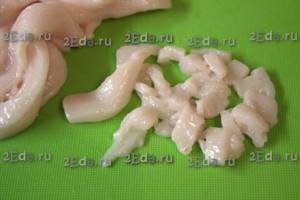
Place chopped pork, beef and lard in a deep bowl.
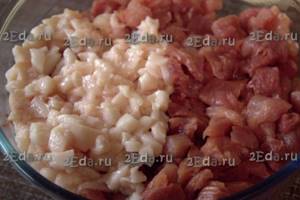
Add salt, sprinkle with ground black pepper and ground coriander, add peeled and pressed garlic (I added granulated garlic).

Dry 2 bay leaves in the microwave (about 1 minute), grind in a mortar (or using a rolling pin) and add to the meat. Knead the meat and lard well until the mass becomes viscous (this will take about 10 minutes). Then cover the bowl of meat with cling film and place in the refrigerator overnight.
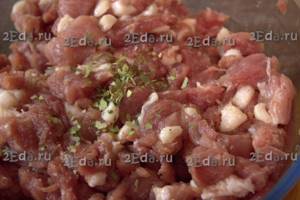
Rinse the natural casing (pork casing) thoroughly to remove salt from the inside and outside.
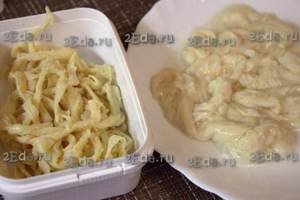
To get rid of the unpleasant odor that may come from the natural casing, prepare a vinegar solution. Pour 400 ml of cold water into a bowl of a suitable size, add 1 teaspoon of soda and 1 tablespoon of vinegar, add peeled onion and cut into half rings, bay leaves. Mix the solution well, place the shell in it and set aside for 1 hour.
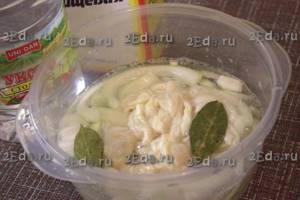
Remove the pork casing (casing) from the vinegar solution and rinse well again.
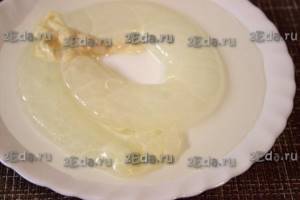
Using a special meat grinder attachment for preparing homemade sausage (cone), fill the casing with minced meat (to do this, you need to tie one end of the casing into a tight knot, and put the other end of the casing on the cone). If there is no such attachment for a meat grinder (cone), then you can cut off the neck of a plastic bottle (as in the photo), tie one end of the shell into a tight knot, and use the cut neck of the bottle to fill the shell with minced meat. Do not fill the shell with meat very tightly, otherwise it will simply burst. If air has formed, you need to pierce the shell with a toothpick (or needle).
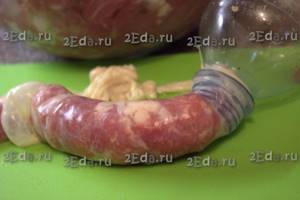
I made sausages about 15 centimeters long. After filling (forming) one sausage 15 centimeters long, I simply twisted the casing several times and began to form the second sausage, filling the next 15 cm of the casing with minced meat. In this way, I formed 3 sausages connected to each other (you can tie the sausages together with threads). Pierce the prepared sausages in several places with a toothpick.
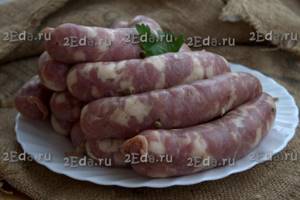
Pour approximately 1.5 liters of water into a saucepan, put on fire and bring to a boil. Carefully place the prepared sausages into boiling water, reduce the heat and simmer for 15-20 minutes from the moment of boiling. Boil all the sausage this way.
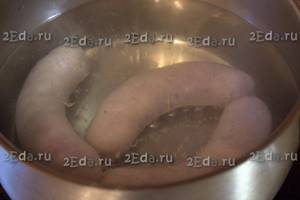
Carefully remove the homemade chopped sausage from the water and let cool. Some of the sausages can be placed in the freezer and frozen for future use.
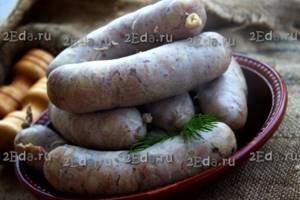
Place the boiled sausage in a frying pan with heated vegetable oil and fry over medium heat on both sides until an appetizing golden color (this will take 7-10 minutes). This homemade chopped sausage does not need to be fried. and bake in an oven preheated to 180 degrees in a baking bag for 15 minutes.
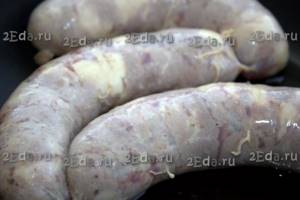
Serve fragrant, juicy homemade minced meat sausage hot with fresh vegetables and herbs.

Bon appetit!
Homemade sausage with spices
Homemade sausage with spices. Photo: A. Sokolov/BurdaMedia
You will need:
- 1.3 kg pork,
- 300 g lard,
- 3 onions,
- 3–4 cloves of garlic,
- 50 g cognac,
- salt, black peppercorns,
- cumin, bay leaf,
- nutmeg, olive oil,
- 1 m of guts.
For decoration:
- 1/2 cucumber and tomato,
- lettuce leaves.
Preparation:
- Rinse and clean the intestines well. Add 1 tbsp to cold water. spoon of vinegar and immerse the intestines in it for 30 minutes.
- Divide all the meat and lard into 2 unequal parts. Pass the smaller part through a meat grinder, cut the larger part into small pieces.
- Chop bay leaf, pepper and cumin. Grate the nutmeg. Peel the garlic and pass through a press.
- Peel the onion, chop finely, fry in a little olive oil until slightly translucent.
- Add chopped meat with lard to the onion and fry it a little, leave until it cools completely.
- Combine meat, lard, salt, pepper, cumin, garlic and cognac (to preserve the color of the meat). Mix the mixture well, compact it and leave to soak for 30–40 minutes.
- Fill the intestines with the minced meat, making sure that the air escapes. Tie the ends with thread. Use a needle to make several punctures in the sausage.
- Sprinkle the sausage with ground bay leaf. Place in a baking sleeve.
- Leave the sausage to steep for 1 hour, and then bake in the oven for 40 minutes at +200°C, and then another 20–30 minutes at +180°C.
- Place the sausage rings on plates, garnish with lettuce leaves, cucumber and tomato slices.
LiveInternetLiveInternet
Thursday, May 16, 2013 18:33 + in quote book There is an opinion that high-quality sausages can only be purchased in specialized butcher shops or at meat processing plants, but this is not so. Sausages prepared at home, according to the most proven recipes, will be appreciated by both family members and guests at the festive feast. In addition, unlike store-bought sausage, homemade sausage does not contain dyes, preservatives, soy, various stabilizers and other harmful substances. Homemade sausage is the most natural product and an excellent dish, both for the family and for the holiday table. Homemade milk sausage recipe
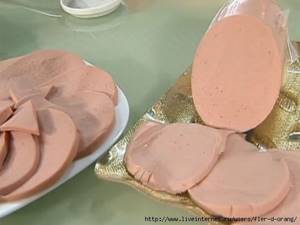
Let's look at the recipe for making milk sausage at home; for supporters of a healthy diet, such sausage is a godsend. Preparing milk sausage is not so difficult; the main thing in this matter is patience and accuracy.
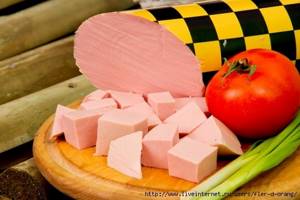
We pass everything through a meat grinder 2 times to make the minced meat airy. In a separate bowl, mix the spices: ground salt 4 tbsp. spoons, ground white pepper 1 tbsp. spoon, sage 2 tbsp. spoons, nutmeg 1 tbsp. spoon, cumin 1 teaspoon, milk powder 200 ml (1 glass), pour into the prepared minced meat and mix well. Pour 400 ml of low-fat milk into the minced meat, add 2 cloves of garlic grated on a fine grater and continue kneading until a homogeneous sticky mass. Next, prepare the shell (preferably already cleaned intestines), soak them in cold salted water for 30 minutes. Then drain the water and dry the shell a little, allowing the water to drain. Having tied the shell on one side, we begin to fill it with ready-made minced meat, using a meat grinder with a special attachment; if you don’t have such an attachment, use a plastic bottle, having previously cut off the bottom. You can also fill it manually. We fill the intestines lightly, tying them with a rope every 20-25 cm. How to cook milk sausage at home If there is no casing, then to give the shape of the boiled sausage, you can take a tetra bag (a liter juice box, which is on store shelves, will do) and wrap it in a sleeve for baking, securing the edges well, or you can simply wrap the finished minced meat in a baking sleeve. Pour water into a large saucepan, lower the prepared milk sausage and cook, from the moment it boils, over low heat for 50-60 minutes at a temperature no higher than 80-90 degrees. Let it cool without opening the bag, and then put it in the refrigerator until it cools completely. Homemade boiled milk sausage is ready. We remove it from the shell, cut it and serve it to the table; you will be pleasantly surprised not only by this exquisite aroma, but also by its taste. Bon appetit! Fler-d-orang Floristry and decoration studio "ALIANA"
Series of messages “Dishes from pork, beef, veal”:
Part 1 - Pork Normandy Part 2 - Pork rolls with spinach ... Part 19 - Doctor's sausage (cooking recipe). Part 20 - DOCTOR'S SAUSAGE at home, a successful experiment. Part 21 - How to cook milk sausage at home Part 22 - HOMEMADE HAM
Series of messages “Chicken, rabbit, turkey”:
Part 1 - Caesar with grilled chicken Part 2 - Turkey rolls with sweet peppers ... Part 18 - Wings in honey sauce Part 19 - Easter table. Chicken jellied Part 20 - How to cook milk sausage at home Part 21 - HOT CHICKEN ROLLS IN BACON. Part 22 - Chicken flambé - a dish of French cuisine. ... Part 24 - Turkey cutlets with vegetables (gluten free) Part 25 - Sauteed chicken breasts with vegetables. French dishes Part 26 - Classic South Indian chicken curry
Series of messages “Appetizers, rolls”:
Part 1 — Banquet dish “Kaleidoscope” Part 2 — Crispy poached quail eggs with bacon ... Part 35 — Doctor’s sausage (cooking recipe). Part 36 - DOCTOR'S SAUSAGE at home, a successful experiment. Part 37 - How to cook milk sausage at home Part 38 - PROFITROLES WITH THREE FILLING OPTIONS. Haute cuisine recipes. Part 39 — QUIZLE LAUREN WITH SPINACH Part 40 — COOK ROLL Part 41 — Garlic shrimp with caramelized vegetables and papaya Part 42 — ALGERIAN BRIC RECIPE
Tags:
homemade milk sausage recipe
Cited 213 times Liked by: 39 users
Like share
0
Like
- 39
I liked the post - 213
Quoted - 0
Saved
- 213
Add to quote book - 0
Save to links
Liked39
0



